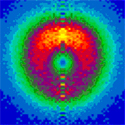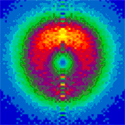Imaging molecular breakup
When low-energy electrons approach molecules, they can attach to them, forming negative ions, rather than scatter. For many molecules this process results in dissociation, leaving neutral and ionic fragments behind. This process plays a key role in radiation damage and can, for instance, cause double-strand breaks in DNA. It is not surprising, therefore, that the electron dynamics in this process called Dissociative Electron Attachment (DEA) is under much investigation, in particular for water, which is ubiquitous in living tissue. However, a clear picture of DEA is lacking for the deceptively simple water molecule due to the complex nuclear and electronic dynamics involving several transient states.
In a recent paper published in Physical Review Letters, Hidehito Adaniya and collaborators from Lawrence Berkeley National Laboratory and the University of California, Davis, both in the US, and Goethe University, Germany, have developed a new approach to probe DEA in water. By combining the calculation of the electron attachment probability in the molecular frame, obtained using ab initio methods, with momentum imaging measurements of the angular distribution of the ionic fragments in the laboratory frame, Adaniya et al. create a powerful reaction microscope. The technique is shown to work even when the standard axial recoil approximation, requiring that the recoil axis not rotate during dissociation, breaks down. This new approach opens the window for studying the dissociation of more complex molecules. – Deniz van Heijnsbergen





